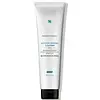What's inside
What's inside
 Key Ingredients
Key Ingredients

 Benefits
Benefits

 Concerns
Concerns

 Ingredients Side-by-side
Ingredients Side-by-side

Water
Skin ConditioningGlycolic Acid
BufferingPEG-8
HumectantAlcohol Denat.
AntimicrobialArginine
MaskingSodium C14-16 Olefin Sulfonate
CleansingSodium Hydroxide
BufferingLactobionic Acid
BufferingCocamidopropyl Betaine
CleansingCitrus Grandis Peel Oil
MaskingPolysorbate 20
EmulsifyingPropylene Glycol
HumectantCaprylyl Glycol
EmollientPhenoxyethanol
PreservativeChlorphenesin
AntimicrobialLimonene
PerfumingWater
Skin ConditioningGlycolic Acid
BufferingCoco-Glucoside
CleansingPropylene Glycol
HumectantAmmonium Polyacryloyldimethyl Taurate
Emulsion StabilisingGlycerin
HumectantSodium Methyl Cocoyl Taurate
CleansingSodium Hydroxide
BufferingAloe Barbadensis Leaf Juice
Skin ConditioningPhytic Acid
Sodium Chloride
MaskingPhenoxyethanol
PreservativeDipropylene Glycol
HumectantCoconut Acid
CleansingCaprylyl Glycol
EmollientSalicylic Acid
MaskingChlorphenesin
AntimicrobialEthylhexylglycerin
Skin ConditioningBoswellia Serrata Gum
MaskingCymbopogon Schoenanthus Oil
MaskingCitral
PerfumingCitric Acid
BufferingPotassium Sorbate
PreservativeSodium Benzoate
MaskingTocopherol
AntioxidantWater, Glycolic Acid, Coco-Glucoside, Propylene Glycol, Ammonium Polyacryloyldimethyl Taurate, Glycerin, Sodium Methyl Cocoyl Taurate, Sodium Hydroxide, Aloe Barbadensis Leaf Juice, Phytic Acid, Sodium Chloride, Phenoxyethanol, Dipropylene Glycol, Coconut Acid, Caprylyl Glycol, Salicylic Acid, Chlorphenesin, Ethylhexylglycerin, Boswellia Serrata Gum, Cymbopogon Schoenanthus Oil, Citral, Citric Acid, Potassium Sorbate, Sodium Benzoate, Tocopherol
Ingredients Explained
These ingredients are found in both products.
Ingredients higher up in an ingredient list are typically present in a larger amount.
Caprylyl Glycol is a humectant and emollient, meaning it attracts and preserves moisture.
It is a common ingredient in many products, especially those designed to hydrate skin. The primary benefits are retaining moisture, skin softening, and promoting a healthy skin barrier.
Though Caprylyl Glycol is an alcohol derived from fatty acids, it is not the kind that can dry out skin.
This ingredient is also used as a preservative to extend the life of products. It has slight antimicrobial properties.
Learn more about Caprylyl GlycolChlorphenesin is a synthetic preservative. It helps protect a product against bacteria in order to extend shelf life. In most cases, Chlorphenesin is paired with other preservatives such as phenoxyethanol and caprylyl glycol.
Chlorphenesin is a biocide. This means it is able to help fight the microorganisms on our skin. It is also able to fight odor-releasing bacteria.
Chlorphenesin is soluble in both water and glycerin.
Studies show Chlorphenesin is easily absorbed by our skin. You should speak with a skincare professional if you have concerns about using Chlorphenesin.
Learn more about ChlorphenesinGlycolic Acid is arguably the most famous alpha hydroxy acid (AHA) with tons of research backing its benefits.
It is found naturally in sugar cane but the form used in skincare is usually synthetic for purity and stability.
Glycolic acid removes the top layer of dead skin cells to allow newer and fresher ones to emerge.
AHAs work by breaking down the structural “glue” that holds old skin cells in place. When that buildup is gone, your skin can renew itself more efficiently.
Research also shows glycolic acid stimulates collagen production, helping to firm and thicken the skin over time. This is one of its biggest advantages over other AHAs.
Overall, glycolic acid helps with:
Fun fact: Glycolic acid boosts skin hydration by helping it produce molecules that increase hyaluronic acid naturally.
To work best, glycolic acid products should have a pH between 3-4 (that’s where exfoliation is most effective but still gentle on skin).
The pH and concentration of a product are key to its effectiveness:
It is normal to feel a slight stinging sensation when using glycolic acid. This usually fades as your skin adjusts.
Because glycolic acid has the smallest molecular size in the AHA family, it can penetrate deeper, which enhances its effectiveness but also makes it more likely to irritate sensitive skin.
If your skin is very sensitive or prone to rosacea, glycolic acid may be too strong; in that case, try milder options like lactic acid or a PHA instead.
Recent studies suggest glycolic acid might even help protect against UV damage. But don’t skip sunscreen! Freshly exfoliated skin is more sensitive to the sun.
Glycolic acid is a skincare superstar. It smooths, brightens, hydrates, and firms the skin. Unless you’re highly sensitive, it’s well worth adding to your routine.
Read more about some other popular AHA's here:
Learn more about Glycolic AcidPhenoxyethanol is a preservative that has germicide, antimicrobial, and aromatic properties. Studies show that phenoxyethanol can prevent microbial growth. By itself, it has a scent that is similar to that of a rose.
It's often used in formulations along with Caprylyl Glycol to preserve the shelf life of products.
Propylene Glycol is an odorless, colorless liquid. As a humectant, it helps skin retain moisture. It also aids in delivering active ingredients.
Another role of this ingredient is preventing a product from melting or freezing. Propylene glycol also adds antimicrobrial properties to a product, elongating product lifespan.
This ingredient is considered an organic alcohol and commonly added into both cosmetics and foods.
Those with sensitive skin or conditions may develop a rash when using this ingredient.
Learn more about Propylene GlycolSodium Hydroxide is also known as lye or caustic soda. It is used to adjust the pH of products; many ingredients require a specific pH to be effective.
In small amounts, sodium hydroxide is considered safe to use. However, large amounts may cause chemical burns due to its high alkaline.
Your skin has a natural pH and acid mantle. This acid mantle helps prevent harmful bacteria from breaking through. The acid mantle also helps keep your skin hydrated.
"Alkaline" refers to a high pH level. A low pH level would be considered acidic.
Learn more about Sodium HydroxideWater. It's the most common cosmetic ingredient of all. You'll usually see it at the top of ingredient lists, meaning that it makes up the largest part of the product.
So why is it so popular? Water most often acts as a solvent - this means that it helps dissolve other ingredients into the formulation.
You'll also recognize water as that liquid we all need to stay alive. If you see this, drink a glass of water. Stay hydrated!
Learn more about Water